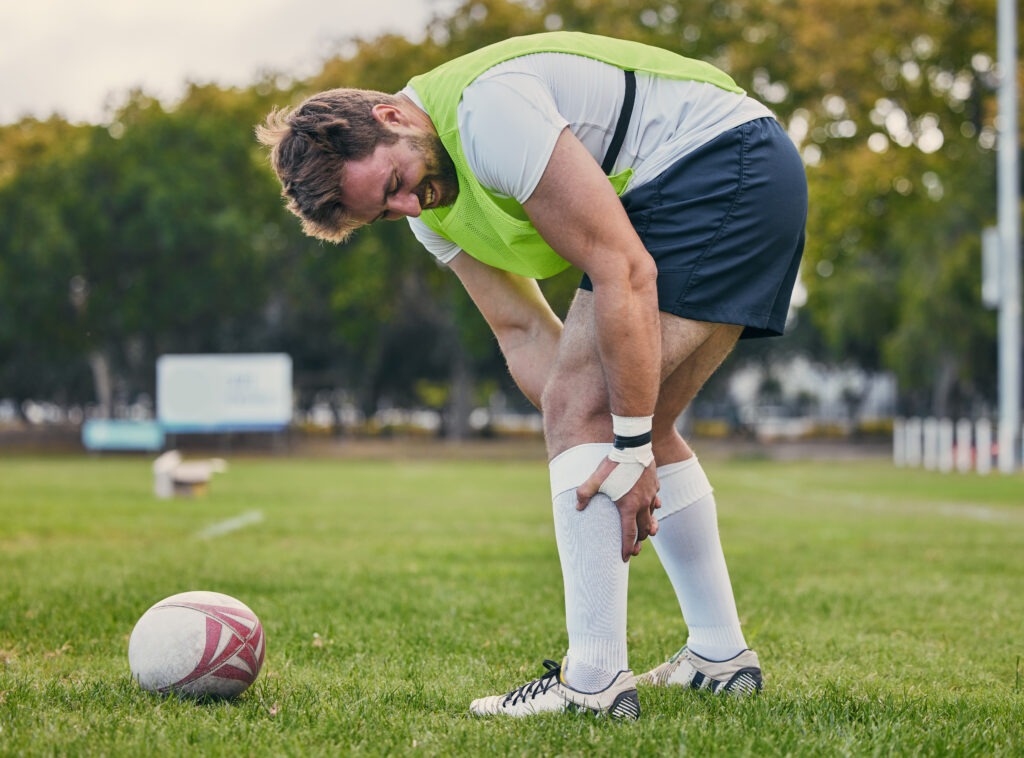Rugby, a high-impact and physically demanding sport, is known for its exhilarating athleticism. However, like any contact sport, rugby carries the risk of injuries. Understanding common rugby injuries and their proper treatment is crucial. It equips players, coaches and anyone involved with knowledge. Let’s explore the types of injuries prevalent in rugby and how to address them effectively.
In this blog, we’ll take a look at:
Types of Rugby Injuries
Head and Neck Injuries
Playing rugby involves intense physical contact, which can lead to head and neck injuries. Concussions and neck strains are among the most common, often requiring immediate attention and appropriate care to prevent long-term complications.
Upper Body Injuries
Shoulder separations, dislocated fingers and rotator cuff injuries are frequently seen in rugby. These injuries can significantly impact a player’s performance and may necessitate tailored rehabilitation measures.
Lower Body Injuries
The lower body is susceptible to various injuries, including hamstring strains, knee ligament injuries and ankle sprains. Proper diagnosis and rehabilitation are essential for players to regain strength and mobility.
Treatment and Rehabilitation
Effective treatment and rehabilitation play a vital role in the recovery process for rugby injuries. Immediate first aid, professional medical care, physiotherapy and a gradual return to play are indispensable for a safe and complete recovery.
Treating Rugby Injuries
Treating rugby injuries involves several key steps to ensure proper healing and a safe return to play. Here are some general guidelines for treating common rugby injuries:
Immediate First Aid
For acute injuries such as sprains, strains or fractures, it’s crucial to administer immediate first aid. After the injury, you would administer R.I.C.E. (Rest, Ice, Compression, Elevation) therapy to reduce swelling and manage pain.
Rehabilitation and Physiotherapy
Physiotherapy rehabilitation plays a vital role in the recovery process. A customised rehabilitation program can help restore strength, flexibility and mobility, allowing the injured player to return to the sport safely.
Gradual Return to Play
Rushing back into the game after an injury can increase the risk of re-injury or worsening the injury. That’s why players need to follow a gradual return-to-play protocol, which may involve progressive physical activity under the guidance of a healthcare professional.
Injury Prevention Strategies
Once recovered, players should focus on injury prevention strategies such as strength and conditioning exercises, proper warm-ups and appropriate protective gear to minimise the risk of future injuries. Every injury is unique and the treatment approach will be tailored to the individual’s condition and needs.
Physiotherapy for Rugby Injuries
Physiotherapy is integral to treating rugby injuries, as it focuses on restoring function, reducing pain and preventing re-injury through targeted exercises and rehabilitation techniques. When it comes to treating rugby injuries with physiotherapy, the approach may vary based on the type and severity of the injury, but here are some general strategies:
Initial Assessment
The physiotherapist team will conduct a thorough assessment to understand the nature and extent of the injury. This may involve evaluating your range of motion, strength, flexibility and any specific functional deficits related to the injury.
Treatment Plan Development
Based on the assessment findings, your physiotherapist will develop a customised treatment plan tailored to the individual’s needs. This plan may include manual therapy, dry needling, shockwave therapy and other evidence-based techniques.
Rehabilitation Exercises
Physiotherapy for rugby injuries often involves rehabilitation exercises to strengthen the affected area, improve flexibility and restore functional movement patterns. These exercises address specific deficits and promote a safe return to play.
Pain Management
Physiotherapists may use various modalities and techniques to manage and relieve pain associated with rugby injuries. This could include manual therapy, taping or other pain-relieving modalities to improve comfort and facilitate the healing process.
Functional Training and Return to Play
As the injured player progresses through physiotherapy, the focus may shift towards functional training tailored to rugby’s demands. This may involve sport-specific exercises and drills to prepare the player for a safe return to play.
Injury Prevention
Our MGS physiotherapists can also educate athletes about injury prevention strategies, proper body mechanics and techniques to minimise the risk of future injuries on and off the field.
Physiotherapy for rugby injuries is not a one-size-fits-all approach. It is highly individualised, with the treatment plan varying based on the specific injury, the athlete’s goals and the stage of recovery. This personalised approach ensures that each player’s unique needs are understood and cared for, promoting effective treatment and rehabilitation.
To fully appreciate rugby’s dynamic nature, it’s essential to recognise the inherent risks associated with the sport. While injuries are unfortunate, understanding how to prevent, identify and treat rugby injuries is crucial for players’ well-being. By promoting a culture of safety, respect and proper medical care, rugby can continue to thrive while prioritising the health and safety of its athletes.
Book now at MGS Physiotherapy
Don’t let rugby injuries sideline you. Book your physiotherapy session at MGS Physiotherapy today for expert care and a speedy recovery.
CALL NOW TO BOOK YOUR APPOINTMENT

